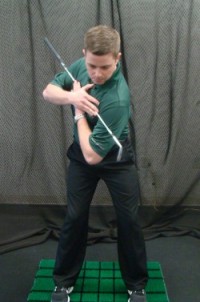In my last post, we began to break the spine into its major parts starting at the base, the lumbar spine. This week, we will move up toward the more mobile section, the thoracic spine.
The thoracic segments of the spine were designed to be relatively mobile in there function when compared to the lumbar sections of the spine. With the alignment of the facet joints, the vertebrae of the thoracic spine allow for side to side bending and rotation. With an excess of anterior pressure on these joints (an increase of kyphosis from poor posture maybe?), the ability to rotate will be affected. Before training rotationally, it is important to promote thoracic extension to relieve any excessive forces that may be present.
In golf and other rotational sports, a majority of movement should be promoted in this area. There is always mention of a good ‘shoulder’ turn in golf. This turning of the shoulders is done by moving the thoracic segments of the spine. When these segments are not performing there necessary duties, the spine above (cervical) or below (lumbar) must make up the difference. Once this relationship is altered, compensation and pain can occur over time due to the unnecessary stresses that are being placed on the body.

A great way to test the amount of movement one has in the mid back is to start by lying on one side with knees bent. Keeping the knees together, roll the shoulder back to the ground trying to touch the shoulder blade to the floor. See Here. Check both sides and determine with side is restricted. Many components contribute to rotational restrictions, so it is key to identify what is the limiting factor (i.e. low back, rib cage, upper chest, etc.). Once you find the limited side and what is causing that limitation, go after the areas that are tight with any modality available.
To Test your mobility standing in golf posture (since this is the way we will be using this new range of motion), rotate the shoulders to one side, then the other, keeping the hips still as you move. Many factors contribute to this complex movement. These will be discussed in the coming weeks on how to help control separation in the golf swing.

Check back again as we explore the cervical spine and move to controlling spinal movement.
If you try these exercises and you find them to be too challenging or uncomfortable, do not continue, until you have consulted with your physician. All exercises for golf should be customized to your needs after a proper evaluation.
Come In and See Us
Want to take your golf to the next level? Our FitGolf® Trainers are experts at working one-on-one with you to tailor a training program to meet the specific needs of your body and help you achieve the results you are hoping to see in your golf.
Want More Resources?
Looking for more exercise resources, blog posts or monthly golf-specific exercise content sent straight to your inbox?
